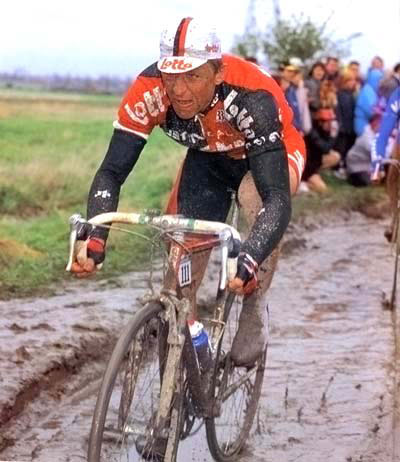
For most, the Classics is a general term used to describe a group of races taking place in late March through early May. While the specific list of races is open to debate, most use the term in reference to Milan-San Remo, the Tour of Flanders (Ronde van Vlaanderen), Ghent-Wevelgem, the Amstel Gold Race, Fleche Wallone, and Liege-Bastogne-Liege. In fact, some might even consider Ghent-Wevelgem and Fleche Wallone “only” semi-classics as they’re a bit shorter than the rest.
A classic is long—usually more than 250km, and is run on a course steeped in tradition and local flavor. Each race is known for the various landmarks—usually hills—that give each event a character and flavor all its own. For example, when a Classics aficionado hears the word “Koppenberg” he thinks of the Tour of Flanders; when he hears “Poggio”; he thinks Milan-San Remo. Cobblestones are also prevalent, especially in April’s Tour of Flanders and Paris-Roubaix (a race with about 50km of them!). The courses rarely change, and when they do its not without public outcry from the municipalities left out. Furthermore, due to their spring dates, the weather usually adds another level of intrigue. Imagine, riding 24mm tires over a crown of wet cobblestones, trying to hold the wheel in front of you despite the constant shower of manure and grit being sprayed in your face. Sound like fun?
In some of the countries hosting them, these races are the biggest events of the year. The Tour of Flanders frequently has more than a million fans lining its route each year, with countless others sitting in bars and behind TV screens to watch the live commentary. In this country in particular, April is like the week before the Super Bowl. Each day’s news begins and ends with new updates, predictions, and speculation about the favorites and outsiders hoping to add a victory to their palmares.
The races themselves suit riders of different types, and thus call for different series of preparatory races in each case. Milan-San Remo has become a race for sprinters, with Paris-Nice or Tirreno Adriatico constituting the traditional warm-ups. Flanders, Ghent, and Roubaix are races for the true hard men; usually riders from northern climates (with the odd Italian or English-speaker here and there) excel here. Dwars door Vlaanderen, E3 Prijs, Brabantse Pijl, and the 3-Days of Depanne are the traditional races for these riders to hone their form and re-acquaint themselves with the cobbles, climbs, and perhaps most importantly, the weather of the region. Amstel Gold, Fleche, and Liege generally suit riders known to excel in stage races and grand tours —these races are known for longer, smoother climbs. The Tour of the Basque Country the week before offers the best preparation.
All in all, it makes for an exciting 6 weeks of racing. I prefer them to the grand tours as the variations in the terrain, the conditions, and the riders make for exciting displays of cycling’s best athletes competing at the sport’s highest level.
For more, head over to Pavé, a blog dedicated to the appreciation of everything these races have come to represent.

I would like to see Gorgeous George win the Hell of the North.
…simple yet great foto…
…& you’ll notice our boy is running a rock shox fork under that mud…
…yep…ol’ georgie boy deserves a belgian classic win considering all the hardcore dust, mud, wind, rain, sun, cobbles, farm lanes, kilometers, ups, downs, abuse, broken bikes n’ bullshit the man has not only survived but thrived in…
…& btw…“our boy” in the foto would be hard man andrei tchmil who won paris – roubaix in ’94 & placed second to franco ballerini in ’95…
…a list of tchmil’s ‘palmares’ shows him to be a consistently tough performer in the spring time classics…
– Anyone else??? – ’94 Paris-Roubaix – Andre Tchmil unloading one major can ‘o whoop-ass…..motherfucker actually bunny-hopped a fucking traffic circle rather than go around it – in the rain no less – remember it like yesterday….that’s why we call ’em classics, right……
btw…..’94 was Greg Lemonds last P-R, he finished it in a plumbers van he hitched a ride from…